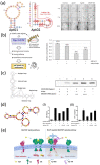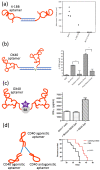Aptamer-Based Probes for Cancer Diagnostics and Treatment
- PMID: 36431072
- PMCID: PMC9695321
- DOI: 10.3390/life12111937
Aptamer-Based Probes for Cancer Diagnostics and Treatment
Abstract
Aptamers are single-stranded DNA or RNA oligomers that have the ability to generate unique and diverse tertiary structures that bind to cognate molecules with high specificity. In recent years, aptamer researches have witnessed a huge surge, owing to its unique properties, such as high specificity and binding affinity, low immunogenicity and toxicity, and simplicity of synthesis with negligible batch-to-batch variation. Aptamers may bind to targets, such as various cancer biomarkers, making them applicable for a wide range of cancer diagnosis and treatment. In cancer diagnostic applications, aptamers are used as molecular probes instead of antibodies. They have the potential to detect various cancer-associated biomarkers. For cancer therapeutic purposes, aptamers can serve as therapeutic or delivery agents. The chemical stabilization and modification strategies for aptamers may expand their serum half-life and shelf life. However, aptamer-based probes for cancer diagnosis and therapy still face several challenges for successful clinical translation. A deeper understanding of nucleic acid chemistry, tissue distribution, and pharmacokinetics is required in the development of aptamer-based probes. This review summarizes their application in cancer diagnostics and treatments based on different localization of target biomarkers, as well as current challenges and future prospects.
Keywords: aptamers; cancer diagnosis; cancer therapy; cell membrane biomarkers; extracellular biomarkers; intracellular biomarkers.
Conflict of interest statement
The authors declare no conflict of interest.
Figures




References
Publication types
Grants and funding
LinkOut - more resources
Full Text Sources

